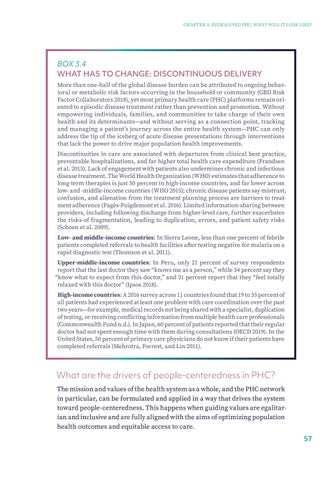CHAPTER 3: REIMAGINED PHC: WHAT WILL IT LOOK LIKE?
BOX 3.4 WHAT HAS TO CHANGE: DISCONTINUOUS DELIVERY More than one-half of the global disease burden can be attributed to ongoing behavioral or metabolic risk factors occurring in the household or community (GBD Risk Factor Collaborators 2018), yet most primary health care (PHC) platforms remain oriented to episodic disease treatment rather than prevention and promotion. Without empowering individuals, f amilies, and communities to take charge of their own health and its determinants—and without serving as a connection point, tracking and managing a patient’s journey across the entire health system—PHC can only address the tip of the iceberg of acute disease presentations through interventions that lack the power to drive major population health improvements. Discontinuities in care are associated with departures from clinical best practice, preventable hospitalizations, and far higher total health care expenditure (Frandsen et al. 2015). Lack of engagement with patients also undermines chronic and infectious disease treatment. The World Health Organization (WHO) estimates that adherence to long-term therapies is just 50 percent in high-income countries, and far lower across low- and -middle-income countries (WHO 2015); chronic disease patients say mistrust, confusion, and alienation from the treatment planning process are barriers to treatment adherence (Pagès-Puigdemont et al. 2016). Limited information-sharing between providers, including following discharge from higher-level care, further exacerbates the risks of fragmentation, leading to duplication, errors, and patient safety risks (Schoen et al. 2009). Low- and middle-income countries: In Sierra Leone, less than one percent of febrile patients completed referrals to health facilities after testing negative for malaria on a rapid diagnostic test (Thomson et al. 2011). Upper-middle-income countries: In Peru, only 21 percent of survey respondents report that the last doctor they saw “knows me as a person,” while 34 percent say they “know what to expect from this doctor,” and 31 percent report that they “feel totally relaxed with this doctor” (Ipsos 2018). High-income countries: A 2016 survey across 11 countries found that 19 to 35 percent of all patients had experienced at least one problem with care coordination over the past two years—for example, medical records not being shared with a specialist, duplication of testing, or receiving conflicting information from multiple health care professionals (Commonwealth Fund n.d.). In Japan, 60 percent of patients reported that their regular doctor had not spent enough time with them during consultations (OECD 2019). In the United States, 50 percent of primary care physicians do not know if their patients have completed referrals (Mehrotra, Forrest, and Lin 2011).
What are the drivers of people-centeredness in PHC? The mission and values of the health system as a whole, and the PHC network in particular, can be formulated and applied in a way that drives the system toward people-centeredness. This happens when guiding values are egalitarian and inclusive and are fully aligned with the aims of optimizing population health outcomes and equitable access to care. 57


